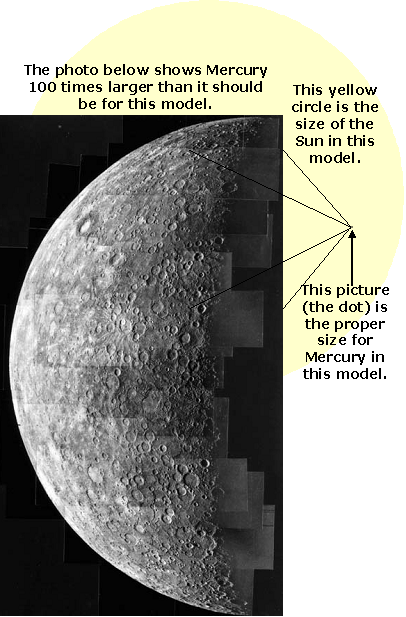Mercury - Next Planet - Back to Planet Walk
 Mercury is the planet closest to the sun, 36,000,000
miles away. On this and all other planet markers, we have a picture of
each planet that is at the same scale as the sun and the distances between
planets in this model. On this scale the planet Mercury is the tiny dot.
Mercury is the planet closest to the sun, 36,000,000
miles away. On this and all other planet markers, we have a picture of
each planet that is at the same scale as the sun and the distances between
planets in this model. On this scale the planet Mercury is the tiny dot.
We will also present a picture that is 500 times
larger in diameter than this scale. To have a model of the solar system
on the same scale as these larger pictures, the Sun would be 2400 inches
in diameter, (200 feet long, as long as the BS Building) and 8350 feet
distant. In this expanded scale, the walk to Pluto would be 51,000 yards,
or 30 miles.
The planet Mercury is only about one-third the diameter
of the Earth and is smaller than any other planet except Pluto. Mercury
is occasionally visible from Earth in the early morning or late evening,
however due to Mercury's closeness to the sun, it is difficult to see.
Close up, Mercury looks much like the moon, with a surface heavily cratered
from meteor impacts. Because it is so close to the sun and has no atmosphere,
Mercury has the greatest variation in surface temperature of all planets
in our solar system. On the daylight side, the side of Mercury facing the
sun, temperatures reach 500 degrees Celsius or 900 degrees Fahrenheit,
hot enough to melt tin. On the night side, the side of the planet away
from the sun, temperatures drop as low as -200 degrees Celsius, or -300
Fahrenheit, the temperature of liquid nitrogen. The average temperature
on the planet Venus is hotter, but varies less.
Astronomers in the 1800's observed that Mercury's
orbit around the sun does not obey Newton's Laws of Motion or Newton's
Law of Universal Gravitation as do all other objects in the solar system.
They thought that this was due to an undiscovered planet orbiting the sun
near to Mercury. The explanation of this deviation was given by Albert
Einstein's General Theory of Relativity, providing a concrete, experimental
verification of Einstein's theories.
Photo Courtesy NASA.
 Mercury is the planet closest to the sun, 36,000,000
miles away. On this and all other planet markers, we have a picture of
each planet that is at the same scale as the sun and the distances between
planets in this model. On this scale the planet Mercury is the tiny dot.
Mercury is the planet closest to the sun, 36,000,000
miles away. On this and all other planet markers, we have a picture of
each planet that is at the same scale as the sun and the distances between
planets in this model. On this scale the planet Mercury is the tiny dot.